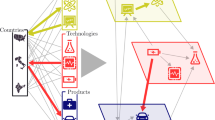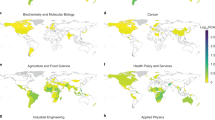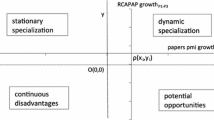Abstract
World science can be characterized as the product of one scientist or nation — knowledge or published papers — used or consumed by other scientists or nations. In this sense, science can be viewed as an input-output system, analogous to the models used in economics. An input-output model of the citation patters of the 18 leading countries in international science was constructed. These countries produce most of the world's science. The large role of the United States in both producing and consuming scientific information is evident in the results. The models also show the role of other countries with respect to each other. For example, the multinational nature of science in countries like the Netherlands and Switzerland is evident. The model can be used to show which countries interact with others, and which do not. Both types of information are useful in discussing trans-national interactions in science.
Similar content being viewed by others
References
E.J. KNAPTON,France: An Interpretive History, Charles Scribner's Sons, New York, 1971, p. 253.
S. B. AHMED, Input-Output Analysis in Environmental Monitoring,IEEE Transactions on Systems, Man and Cybernetics, SMC3, 6 (1973) 537–8.
K. CHEN, Input-Output Economic Analysis of Environmental Impact,ibid,, SMC 3, 6 (1973) 539–547.
I. GUTMANIS, Environmental Implications of Economic Growth in the U.S. 1970 to 2000-Input-Output Analysis,ibid,, 6 (1973) 583.
L. D. MAXIM, C. L. BRAZIE, Multistage Input-Output Model for Evaluation of Environmental Impact of Energy Systems,ibid, 6 (1973) 583–587.
W. H. MIERNYK, Regional Input-Output Pollution Abatement Modell,ibid, 6 (1972) 575–577.
T. PAGE, Pollution Affecting Producers in an Input-Output Context,Ibid, 6 (1973) 555–561.
D. SHETER, Forecasting Industrial Pollution in Haifa Bay Area With an Innput-Output Model,Socio-Economic Planning Sciences, 7 (1973) No. 5, 397–406.
A. S. COHEN, A. P. HURTER, Input-Output Analysis of Costs of Air Pollution Control,Management Science, 21B (1974) No. 4, 453–461.
F. GIARRATANI, Air Pollution Abatement-Output and Relative Price Effects — A Regional Input-Output Simulation,Environment and Planning, 6 (1974) No. 3, 307–312.
M. CHATTERJEE, Dynamic Balanced Regional Input-Output Model of Pollution Control,ibid,, 7 (1975) 21–34.
W. A. FLICK, Environmental Repercussions and Economic Structure — Input-Output Approach — Comment,Review of Economics and Statistics, 56 (1974) No. 1, 107–109.
W. LEONTIEF, Environmental Repercussions and Economic Structure — Input-Output Approach — Reply,ibid,, 56 (1974) No. 1, 109–110.
F. GIARRATANI, Air Pollution Abatement and Man-power Requirements — A Regional Input-Output Analysis,Annals of Regional Science, 9 (1975) No. 2, 83–90.
W. H. MIERNYK, J. T. SEARS,Air Pollution Abatement and Regional Economic Development — Input-Output Analysis, Heath, Lexington, Mass., 1974.
M. B. HOCKING, Chemical Input-Output Analysis of Municipal Solid-Waste Incineration,Journal of Environmental Systems, 5 (1975) No. 3, 163–183.
J. J. DOUGLAS, Use of a Modified Input-Output Multiplier for Land Use Evaluation,Australian Journal of Agricultural Economics, 17 (1973) No. 1, 68–75.
M. L. PARKER, Input-Output View of Agriculture in Papua-New Guinea,ibid, 18 (1974) No. 1. 32–39.
D. MULKEY, J. C. HITE, Input Analysis of Energy Use by South Carolina Agriculture,American Journal of Agricultural Economics, 56 (1974) No. 5, 1203.
G. SCHLUTER, Combining Input-Output and Regression Analysis in Projection Models —Application to Agriculture,ibid, 56 (1974) No. 5, 1207.
C. ESTRUP, Energy Consumption Analysis by Application of National Input-Output Tables,Industial Marketing Management, 3 (1974) No. 4, 193–200.
J. B. PENN, B. McCARL, O. DOERING, L. BRINK, Structural Input-Output Modelling of Food and Fiber System Under Conditions of Fuel Scarcity,American Journal of Agricultural Economics, 56 (1974) No. 5, 1203.
M. A. SWIFT, Fuel Substitution in Input-Output Models — Non-linear Programming Approach,Operations Research, 23 (S2) B427 (1975).
M. O. FILANI, Air Traffic Forecasting — Input-Output Technique Approach,Regional Studies, 7 (1973) No. 3, 333–338.
S. L. GRAY, J. R. McKEEAN, D. D. ROHDY, Estimating Impact of Higher Education from Input-Output Models — Case Study,Rocky Mountain Social Science Journal, 12 (1975) No. 1. 1–10.
B. C. LIU, Regional Hospital Needs Projection — Input-Output Approach,Socio-Economic Planning Sciences, 10 (1976) No. 1, 37–42.
A. A. KONIUS, Commensuration of Labor by Means of an Input-Output Table,Matekon, 9 (1973) No. 4, 31–42.
P. C. NYSTROM, Input-Output Processes of Federal Trade Commission,Administrative Science Quarterly, 20 (1975) No. 1, 104–113.
C. P. BOURNE, The World's Technical Journal Literature: An Estimate of Volume, Origin, Language, Field, Indexing and Abstracting,American Documentation, (1962) 159–168.
F. NARIN,Evaluative Bibliometrics, Computer Horizons Inc., Cherry Hill, N. J., 1976.
Published by the Institute for Scientific Information, Philadelphia, Pa.
H. CASON, M. LUBOTSKY, The Influence and Dependence of Psychological Journals on Each Other,Psychological Bulletin, 33 (1936) 95–103.
A. K. GUPTA, Characteristics of Documents cited by Indian Physicists: A Case Study,DRTC Seminar (India), No. 7, Paper JB, 1969.
F. NARIN, M. P. CARPENTER, National Publication and Citation Comparisons,Journal of the American Society for Information Science, 26 (1975) 80–93.
L. V. XHIGNESSE, C. E. OSGOOD, Bibliographic Citation Characteristics of the Psychological Journal Network in 1950 and in 1960,American Psychologist, 22 (1967) 778–791.
R. S. DANIEL, C. M. LOUTTIT,Professional Problems in Psychology, Prentice-Hall, New York, 1953.
J. B. KRUSKAL, Multidimensional Scaling by Optimizing Goodness of Fit to a Non-metric Hypothesis,Psychometrika, 29 (1964) No. 1, 1–27.
J. B. KRUSKAL, Nonmetric Multidimensional Scaling: A Numerical Method,Psychometrika, 29 (1964) No. 2, 115–129.
H. INHABER, Where Scientists Publish,Social Studies of Science, 7 (1977) No. 3, 388–394.
Personal communication, F. NARIN, President, Computer Horizons Inc., Cherry Hill, N. J., Nov. 12, 1975.
H. INHABER, The Leading Edge of Science in Canada,Research Policy, 7 (1977) 88–98.
G. PINSKI, Influence and Interrelationship of Chemical Journals,Journal of Chemical Information and Computer Sciences, 17 (1977) 67–74.
J. D. FRAME, F. NARIN, M. P. CARPENTER, The Distribution of World Science,Social Studies of Science, 7 (1977) No. 4, 501–516.
Author information
Authors and Affiliations
Rights and permissions
About this article
Cite this article
Inhaber, H., Alvo, M. World science as an input-output system. Scientometrics 1, 43–64 (1978). https://doi.org/10.1007/BF02016839
Received:
Revised:
Issue Date:
DOI: https://doi.org/10.1007/BF02016839




